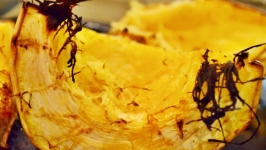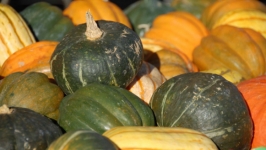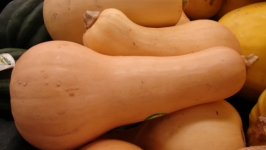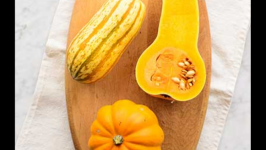Seven Winter Squashes To Look For This Fall
Winter squash is a wonderfully colorful and delicious vegetable, versatile in the kitchen and stores well enough to use as a decorative display on your front porch or tabletop for a month or two. They come in an amazing array of colors, shapes, sizes, and varieties. Here are some you’ll probably see at the farmers’ market.
Acorn Squash: Nutty and meaty taste, usually mottled dark green with touches of pale orange. These are popular because of their small size—one squash can be cut in half and baked for two generous servings. The rind is very hard. Select acorn squash with as much bright color on the rind as possible and is heavy for its size. Store in a cool, dry place for up to six months.
Banana Squash: Nice, even taste, very meaty. Rind is an overall yellowish-orange while the inside is darker in color. This variety is so large that it is usually found cut into smaller chunks for sale. Very tasty, but known for its beautiful golden colored flesh. Select those that are heavy for their size and a nice even color overall. Store in a cool, dry place for up to six months.
Butternut Squash: Sweet, moist, and nutty taste. Pale yellow- orange in color. This variety is popular because it is easy to use. The rind is thin enough to peel off with a vegetable peeler. Store in a cool, dry place.
Delicata Squash: Also called peanut squash or Bohemian squash. This is one of the tastier winter squashes, with creamy pulp that tastes a bit like corn and sweet potatoes. Size may range from 5 to 10 inches in length. The squash can be baked or steamed. The thin skin is also edible. The delicata squash is actually an heirloom variety, a fairly recent re-entry into the culinary world. Its thinner skin makes it easy to prepare.
Kabocha Squash: Kabocha is the generic Japanese word for squash, but refers most commonly to a squash of the buttercup type. This squash has a green, bluish-gray or a deep orange skin. The flesh is deep yellow. Kabocha squash may be cooked whole or split lengthwise (removing seeds). It has a rich, sweet flavor, often dry and flaky when cooked. Use in any dish in which buttercup squash would work.
Spaghetti Squash: Generally mild squash taste and yellow in color inside and out. After it is cooked you can dig a fork into the flesh and pull out long yellow strands that resemble spaghetti. Though it tastes like squash, the “noodles” can serve as a low-calorie substitute for pasta. Select spaghetti squash that is heavy, has tight skin and gives a good “thump.” Store in cool, dry place up to six months.
Sweet Dumpling: Teacup-shape fruits that are ivory with dark green or orange stripes and pale orange flesh. The 4-inch-diameter squash is sweet and a good size for stuffing. Pretty for decorations.






